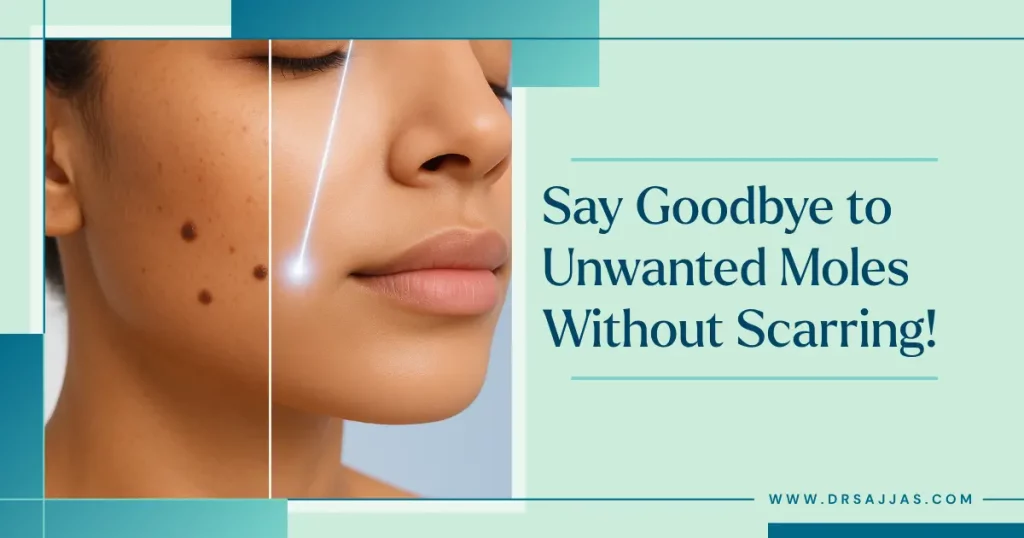
For years, mole removal meant accepting the trade-off: removing an unwanted mark meant getting a scar in return. Traditional surgical excision with scalpels and sutures often left visible scars that could be just as concerning as the original mole. But laser technology has revolutionized mole removal, offering a virtually scar-free solution that seems almost too good to be true.
So how does laser treatment achieve what was once impossible?
Understanding Traditional vs. Laser Mole Removal
Conventional surgical excision cuts deep into the skin, removing the mole along with surrounding tissue. This method:
- Creates significant tissue trauma
- Requires sutures that leave stitch marks
- Penetrates multiple skin layers
- Results in permanent scarring in most cases
Laser mole removal, however, takes a completely different approach that preserves skin integrity while effectively eliminating unwanted pigmentation.
The Science Behind Scar-Free Laser Removal
Selective Photothermolysis: The Key to Precision
Laser mole removal works through a sophisticated process called selective photothermolysis. Here’s how it achieves scar-free results:
Targeted Energy Delivery: The laser emits specific wavelengths of light that are absorbed exclusively by melanin pigment within the mole. Surrounding skin tissue remains completely unaffected because it doesn’t absorb these particular wavelengths.
Controlled Depth Penetration: Unlike surgical cutting, lasers deliver energy at precise depths, targeting only the layers containing mole cells without damaging deeper dermal structures responsible for scarring.
Thermal Fragmentation: The absorbed laser energy heats melanin particles, causing them to fragment into microscopic pieces that your body’s immune system naturally eliminates over time.
Why Laser Treatment Minimizes Scarring
1. No Physical Cutting
Lasers use light and heat energy rather than physical incision, meaning no blade comes into contact with your skin. Without cutting, there’s no wound requiring healing through scar tissue formation.
2. Minimal Thermal Damage
Modern laser systems deliver energy in ultra-short pulses (measured in nanoseconds). This rapid delivery prevents heat from spreading to surrounding tissue, a phenomenon called thermal confinement.
3. Preserved Skin Architecture
Because lasers target only pigmented cells, the collagen framework and skin structure remain intact. Your skin maintains its original architecture while the pigmented cells disappear.
4. Natural Healing Process
The body processes fragmented melanin particles through natural metabolic pathways, allowing the skin to heal from within without forming excessive scar tissue.
The Laser Mole Removal Procedure
Step 1: Assessment and Numbing. A topical anaesthetic cream or local injection ensures complete comfort during the procedure.
Step 2: Laser Application The laser handpiece delivers controlled pulses directly to the mole. Patients typically describe the sensation as minor snapping or warmth.
Step 3: Immediate Results The mole immediately darkens or forms a light crust, which naturally sloughs off within 7-10 days.
Step 4: Progressive Fading Over the following weeks, the remaining pigment continues to fade as your body eliminates fragmented melanin.
Factors That Influence Scarring Risk
While laser removal dramatically reduces scarring, certain factors affect outcomes:
Mole Characteristics:
- Flat moles respond better than raised moles
- Surface pigmentation removes more cleanly than deep-rooted moles
- Size and depth determine the treatment sessions needed
Skin Type Considerations:
- Fitzpatrick Type I-III (lighter skin) typically shows better results
- Darker skin tones require specialized laser settings to prevent hypopigmentation
Post-Treatment Care:
- Sun protection prevents pigmentation changes
- Proper wound care ensures optimal healing
- Avoiding picking at treated areas prevents complications
When Multiple Sessions Are Needed
Deeper or darker moles may require 2-3 laser sessions spaced 4-6 weeks apart. This gradual approach:
- Removes pigment in layers without aggressive tissue damage
- Allows skin to heal completely between treatments
- Produces superior cosmetic outcomes with minimal scarring risk
Your Path to Flawless Skin
If you’ve been living with unwanted moles, modern laser technology offers a solution that once seemed impossible: effective removal without the scarring that plagued traditional methods.
Ready to experience scar-free mole removal with advanced laser technology? Dr Sajjas Skin, Hair & Laser Clinic specializes in precise laser treatments that deliver exceptional cosmetic results while prioritizing your skin’s health and integrity.



